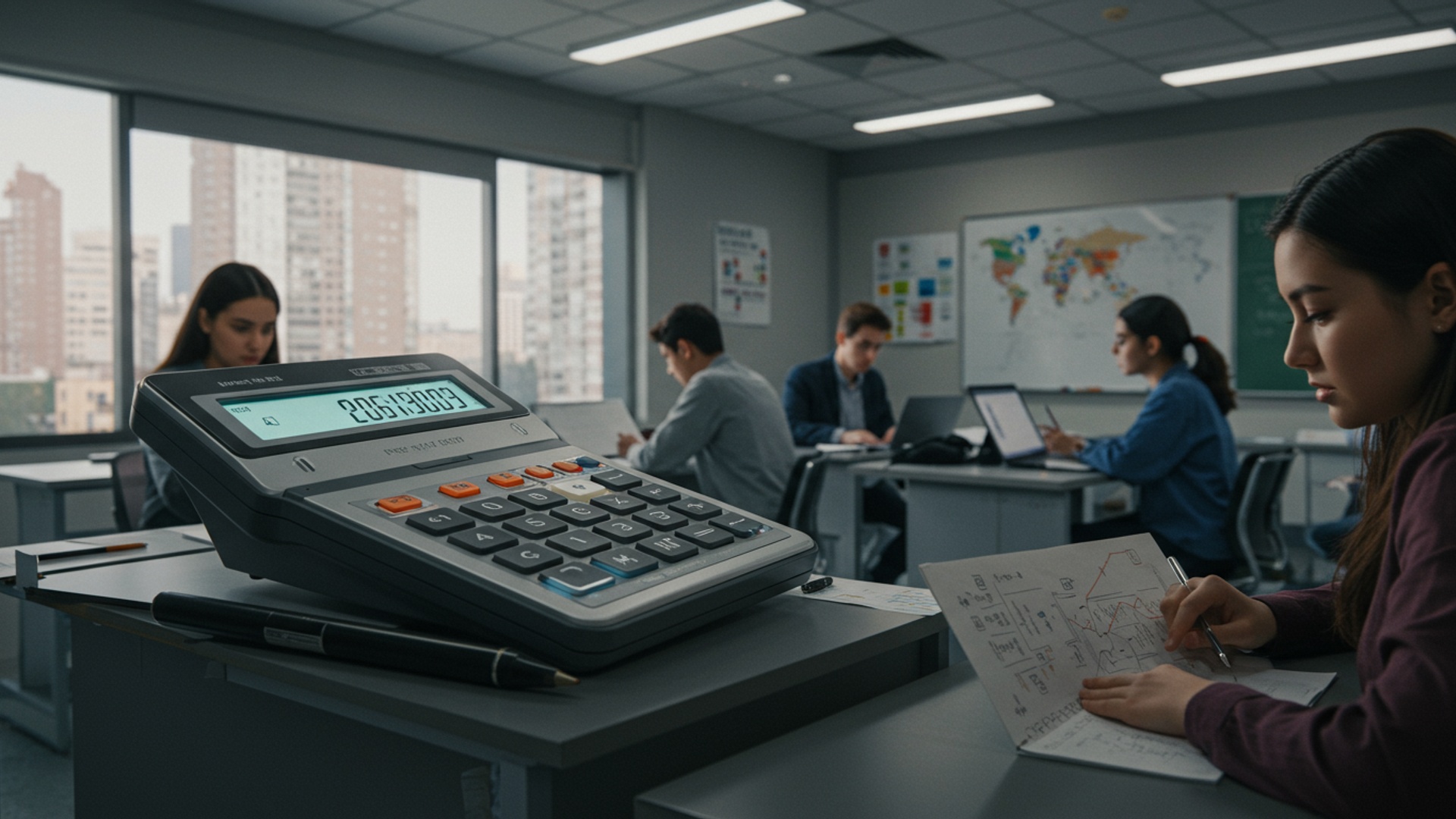For GATE aspirants, the virtual calculator, a mandatory tool since its inception, demands more than just basic familiarity; it requires strategic mastery. Many candidates stumble over its unique interface, misinterpreting scientific notation outputs or struggling with order of operations, which directly impacts numerical accuracy in critical problems like solving linear equations or analyzing circuit transfer functions. Mastering effective GATE Exam virtual calculator usage tips is paramount for success, especially with the increasing prevalence of multi-step numerical answer type questions. Optimizing your interactions, from efficient data entry to leveraging memory functions, ensures you minimize calculation time and maximize precision. This crucial skill, often overlooked, directly dictates your ability to complete the exam efficiently and accurately.

Understanding the GATE Exam Virtual Calculator
The Graduate Aptitude Test in Engineering (GATE) is a highly competitive examination in India that primarily tests the comprehensive understanding of various undergraduate subjects in engineering and science. A crucial tool provided during this computer-based test is the virtual calculator. Unlike traditional examinations where physical scientific calculators were permitted, GATE transitioned to an on-screen virtual calculator to ensure fairness, prevent malpractices. standardize the examination environment for all candidates. This virtual tool is an integral part of the examination interface. proficiency in its use is paramount for effective time management and accuracy. Understanding its interface and functionalities is the first step towards mastering GATE Exam virtual calculator usage tips. The virtual calculator provided in the GATE exam is a standard scientific calculator, designed to perform basic arithmetic operations, trigonometric functions, logarithmic calculations. more complex scientific operations. Its primary purpose is to assist candidates with numerical problems without requiring them to rely on mental calculations or external devices, thus allowing them to focus purely on problem-solving. While it mimics a physical calculator, its on-screen nature introduces unique challenges, particularly regarding speed and accuracy.
Key Features and Interface of the Virtual Calculator
The GATE virtual calculator typically features a layout similar to a standard scientific calculator. It includes a display screen, numerical keys (0-9, decimal point), basic arithmetic operators (+, -, , /). a range of scientific functions. Familiarity with this interface is critical.
- Display Screen: Shows the input numbers and the results of calculations. It often has a limited display, so managing long expressions or multiple steps requires careful attention.
- Numerical Pad: Standard 0-9 digits and a decimal point.
- Basic Operators: Addition (+), Subtraction (-), Multiplication (), Division (/).
- Memory Functions: Often includes M+, M-, MR, MC to store and recall values, which is incredibly useful for multi-step problems.
- Scientific Functions: These are typically grouped and include:
- Trigonometric functions (sin, cos, tan. their inverses: asin, acos, atan).
- Logarithmic functions (log, ln).
- Exponential functions (e^x, 10^x).
- Power functions (x^y, x^2, sqrt).
- Factorial (n!) .
- Parentheses: Crucial for defining the order of operations in complex expressions.
- Clear/All Clear (C/AC): To clear the current entry or reset the entire calculator.
Essential Functions for GATE Exam Calculations
While the virtual calculator offers numerous functions, certain ones are used more frequently in GATE exam problems across various disciplines. Mastering these functions and understanding their proper usage is a cornerstone of effective GATE Exam virtual calculator usage tips.
- Trigonometric Functions (sin, cos, tan, asin, acos, atan): Essential for problems in Mechanics, Electrical Circuits, Signal Processing. various other engineering disciplines. Always ensure the calculator is in the correct angle mode (degrees or radians) as required by the problem. The GATE virtual calculator usually defaults to radians, which is often the required mode for engineering problems. it’s crucial to verify.
- Logarithmic and Exponential Functions (log, ln, e^x, 10^x): Widely used in Chemistry, Thermodynamics, Control Systems. many numerical methods. Understanding the difference between natural logarithm (ln) and base-10 logarithm (log) is vital.
- Power and Root Functions (x^y, x^2, sqrt): Indispensable for almost any quantitative problem, from calculating areas and volumes to solving equations involving exponents.
- Memory Functions (M+, M-, MR, MC): These are often overlooked but are powerful tools for managing intermediate results in multi-step calculations, reducing the need to re-enter values and minimizing errors.
M+: Adds the current displayed number to the memory.
M-: Subtracts the current displayed number from the memory.
MR: Recalls the number stored in memory to the display.
MC: Clears the memory.
- Parentheses (): Absolutely critical for maintaining the correct order of operations. Many errors arise from incorrect use or omission of parentheses. For example, to calculate
(2 + 3) 4, you must use parentheses; otherwise,
2 + 3 4would evaluate to
2 + 12 = 14instead of
5 4 = 20.
Speed Enhancement Strategies for the Virtual Calculator
Speed is of the essence in the GATE exam. Every second saved on calculations can be invested in solving more complex problems or reviewing answers.
- Keyboard Shortcuts (if available): While the virtual calculator is primarily mouse-driven, some versions might support keyboard input for numbers and basic operations. Practice identifying if the numerical keypad on your physical keyboard can be used, as this significantly increases input speed. For instance, typing
23+5=is much faster than clicking each button. But, complex functions often still require mouse clicks.
- Order of Operations (PEMDAS/BODMAS): Even though the calculator follows standard order of operations, consciously applying it helps in structuring complex calculations. Breaking down a problem into smaller, manageable steps can prevent errors and speed up execution.
- Efficient Use of Memory Functions: Instead of writing down intermediate results and re-entering them, use M+, M-, MR. This saves time and reduces transcription errors. For example, if you need to calculate
(A + B) / (C - D):
- Calculate
A + B, then use
M+.
- Calculate
C - D.
- Then perform
MR / (C - D result).
- Calculate
- Minimizing Mouse Movement: With practice, you can develop muscle memory for the calculator’s layout, allowing your mouse movements to become more precise and efficient. Try to anticipate the next button you’ll need.
- Practice with Sample Tests: The most effective way to improve speed is consistent practice using the actual GATE virtual calculator interface, available on the official GATE website or mock test platforms. This familiarizes you with its quirks and layout.
Accuracy Improvement Techniques for the Virtual Calculator
Speed without accuracy is counterproductive. Ensuring your calculations are correct is just as vital, if not more so.
- Double-Checking Inputs: A common source of error is simply entering the wrong numbers or operators. After entering a complex expression, quickly glance at the display to ensure it matches your intended input before pressing equals.
- Break Down Complex Calculations: Instead of trying to type out a very long expression with many parentheses, break it into smaller, verifiable steps. Calculate one part, note the result (or store in memory), then proceed to the next. This makes debugging errors easier.
- Understanding Function Behavior: Know what each function does. For instance,
log(x)is base 10,
ln(x)is base e. For trigonometric functions, confirm the angle mode (degrees/radians) before calculation. A wrong mode can lead to significantly incorrect answers.
- Anticipate Order of Operations: While the calculator handles it, understanding PEMDAS/BODMAS helps you structure your input correctly, especially with parentheses. Incorrect parenthesization is a frequent cause of errors.
- Sanity Checks: After obtaining a result, perform a quick mental sanity check. Does the answer make logical sense in the context of the problem? For example, if calculating the length of a hypotenuse. your answer is smaller than one of the legs, you’ve made an error.
- Clear Button Usage: Use the ‘Clear’ or ‘AC’ button judiciously. ‘C’ usually clears the last entry, while ‘AC’ clears everything. Knowing the difference prevents accidental clearing of entire expressions.
Comparison with Physical Calculators
The GATE virtual calculator has distinct differences from physical scientific calculators that candidates are often accustomed to. Understanding these differences is a crucial part of GATE Exam virtual calculator usage tips.
| Feature | Physical Calculator | GATE Virtual Calculator |
|---|---|---|
| Input Method | Tactile buttons, often with clear feedback. Fast for experienced users. | Mouse clicks (primary), sometimes keyboard input for numbers. Slower, lacks tactile feedback. |
| Display | Multi-line display common, allowing review of previous entries/expressions. | Typically single-line display, making complex expression review difficult. |
| Speed | Generally faster due to tactile input and muscle memory. | Slower due to mouse dependency; requires more focus on cursor movement. |
| Error Correction | Easier to backspace/edit specific parts of an expression. | Often requires clearing and re-entering if an error is made mid-expression. |
| Functions | Wide range of scientific functions, often dedicated buttons for common ones. | Standard scientific functions available, sometimes nested in menus or fewer direct buttons. |
| Familiarity | Candidates often use their preferred model for years. | Standardized interface, may be new to candidates. |
| Graphing/Programming | Some advanced models offer graphing/programming features (not allowed in exams). | No graphing or programming capabilities. Simple, scientific functions only. |
The key takeaway from this comparison is that while the virtual calculator performs the same mathematical operations, the user experience is significantly different. This necessitates dedicated practice with the virtual tool itself.
Practice and Preparation for the Virtual Calculator
Effective preparation for the GATE virtual calculator involves more than just knowing its functions; it requires consistent, simulated practice.
- Utilize Official Mock Tests: The GATE organizing body releases official mock tests that include the actual virtual calculator interface. This is the single most valuable resource for practice. Solve problems from previous year GATE papers using this specific calculator.
- Focus on Speed and Accuracy Simultaneously: Don’t just aim for correct answers; time yourself. Try to improve your input speed and minimize errors. Identify common mistakes you make (e. g. , wrong angle mode, parentheses errors, miskeying numbers).
- Integrate Calculator Practice into Study Routine: Whenever you solve numerical problems from textbooks or previous year papers, use the virtual calculator. Make it a habit, not an afterthought.
- Master Memory Functions: Actively look for opportunities to use M+, M-, MR. These functions are often underutilized but can save significant time and reduce errors in multi-step problems.
- grasp Function Domains: Be aware of input limitations. For example,
sqrt(-ve number)or
log(0)will result in errors. Knowing these helps prevent wasting time on invalid calculations.
- Practice with Different Problem Types: Ensure you practice calculations for various subjects – be it fluid mechanics, electrical circuits, thermodynamics, or signal processing – as each might require specific functions or calculation patterns. Consistent GATE Exam virtual calculator usage tips across diverse problems solidifies your skill.
Conclusion
Mastering the GATE virtual calculator isn’t merely about inputting numbers; it’s about building computational fluency under pressure. Just as a sprinter trains their stride, you must develop muscle memory for common operations and function keys. From my own exam experiences, I’ve learned that consistent, dedicated practice—always using the virtual calculator for every problem, not just the complex ones—is paramount. This isn’t optional; it’s a non-negotiable part of your GATE preparation, especially with the increasing number of numerical answer type questions prevalent in recent years, a trend seen strongly in GATE 2024. Focus intently on minimizing common errors such as misplaced parentheses or scientific notation blunders, which can be easily avoided with diligent practice. Remember, saving even five seconds per calculation adds up to precious minutes across the entire paper, potentially making the difference between clearing the cut-off and securing a top rank. Embrace this indispensable tool, not as a hindrance. as a powerful ally. Your diligence in perfecting its use will undoubtedly translate into the speed, accuracy. ultimately, the success you deserve in the GATE examination.
More Articles
Accessing Top Free Mock Tests for GATE 2024: Boost Your Exam Prep
Demystifying GATE Multiple Select Questions: Strategies for Acing MSQ Sections
Navigating Biotech Careers: Essential Steps and Skills for a Successful Future in Science
Top Biotechnology Careers: Exploring High-Demand Roles and Lucrative Salary Expectations for 2025
FAQs
Why is mastering the GATE virtual calculator so vital for the exam?
It’s the only calculator you’re allowed to use in the GATE exam. If you’re not comfortable and fast with it, you’ll waste precious time and might even make errors, costing you marks. It’s a critical tool for solving numerical problems efficiently.
How different is the GATE virtual calculator from the scientific calculator I usually use?
Quite different! It’s a basic scientific calculator without many of the advanced features you might be used to. Key differences include no dedicated ‘Ans’ button, a more basic memory function. the way operations like powers or roots are entered. It requires a specific input sequence for many functions.
Which specific functions or features should I really focus on mastering for speed and accuracy?
Definitely get comfortable with memory functions (M+, M-, MR, MC), trigonometric functions (sin, cos, tan and their inverses), logarithms (log, ln). power functions (x^y, e^x). Also, comprehend the order of operations and how to use parentheses effectively to avoid errors.
Got any quick tips to speed up my calculations using this virtual tool?
Absolutely! Practice using keyboard shortcuts instead of clicking with the mouse – it’s much faster. Avoid re-entering numbers by using memory functions for intermediate results. Also, try to simplify expressions on paper first if possible, reducing complex calculations on the calculator.
How can I make sure I don’t mess up calculations and lose marks?
The best way is to practice consistently. Double-check your input, especially for complex expressions. Break down long calculations into smaller steps. comprehend how the calculator handles operator precedence. And always verify your final answer if time permits, maybe by doing a quick mental check or re-entering it if it’s critical.
Where can I practice using the exact GATE virtual calculator before the actual exam?
The most authentic place is the official GATE website. They provide a link to the actual virtual calculator simulation. Also, many good online mock tests and coaching institute platforms integrate the same virtual calculator, offering a realistic practice environment.
Is it really worth spending a lot of time just practicing with the virtual calculator?
Yes, absolutely! Think of it as a crucial skill. A few hours of dedicated practice can save you significant time and prevent costly errors in the exam, potentially boosting your score by several marks. It’s an investment that pays off big time during the exam.



